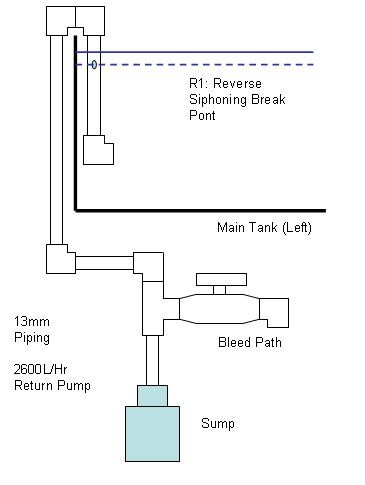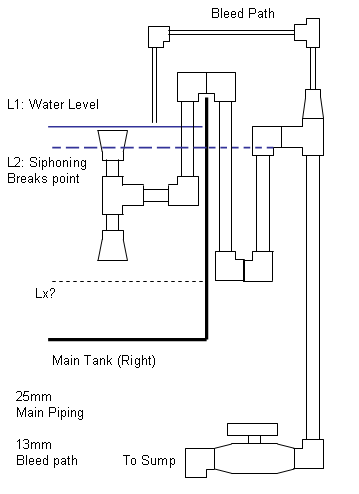
desm0nds
Newbie 1-
Posts
43 -
Joined
-
Last visited
Content Type
Profiles
Forums
Gallery
Everything posted by desm0nds
-
Cool! Finally I can start to work on it. Will let you guys know the result once its done. Got to go shopping for the "material".
-
Next is the returned path: 1) A ball valve is again used to regulate flowrate into main tank. Excess water will flow back into sump. 2) A reverse siphoning breaking hole at the outlet below the water level. Well, can this system works?
-
ok, I have modified the design a bit more, hoping that it will resolve all the outstanding issue. Firstly, the siphoning path: 1) As can be seen from the picture, A double U channel is used to restart siphoning after recovery from pump failure. 2) A surface skimmer and a mid tank inlet. 3) A ball valve at the bottom to regulate the flowrate into the sump. 4) A "non-full" siphoning path and also act as a bleed path for access water to flow back into the main tank when ball valve needs to be used. There is still 1 point here need to be clarify. Lx. This level. Should it be below the mid tank inlet or it doesnt matter at all?
-
hi delirium, thanks for sharing. But dun really can figure out from the diagram how is the setup like. You mentioned that you have 2 return path into the tank. One just benethe the water surface and the other half way down. Assuming that I get the orientation right, the green path, i.e return path is splitted across the Tee. One to left and one to right. ey....so how should I look at it to see theoutlet beneath the water level and half way down tank? Appreciate if you could elaborate further on this. Porc, the pictures are fine. thanks. Taken with a phone camera? When the korean design the Hyundai, nobody knows that the jap are working on the Toyota. In short, originality varies among people pt of view. Since we are talkin about this extra cylinder idea, one of my friend did came up with somewhat similar. Only this time, the sylinder is outside the tank. Problem is, the cylinder is able to hold up to 3L of water i.e. 3Kg of weight and I couldnt possibily hang it on my tank's wall. So the idea was abandoned. But its a great idea to have it inside the tank. you are using 1200l/hr pumping rate. how do you deal with water circulation in the main tank? I had experiment with a 1600 in my tank and by positioning it abt 4 inch below the water top, I get a small current in the tank. Enough to stir up small debris. Initally it did stir up the sand. But after I reposition its outlet to blow at the rocks, the current breaks apart but still able to stir up small debris. My whole idea is to be able to have a steady water current in the tank to disturb the bottom debris so as to be able to suck in by the siphoning in the middle inlet to be collected in the sump filter. And I need a good water cycle to the filter system so as to have cleaner water in the main tank. That's way the idea for a sump tank. Reduce nitrate level, reduce growth of diatoms etc. Eventually lesser maintenance work in term of water changing and sandbed disturbing to remove diatoms. Well didnt know that it involved so much studies and experiment. But since I started the idea, I will definitely follow thru till the end. For the sake of a cleaner environment for my fishes.
-
Had wanted to ask you, the opened end top. What's it function? I guess its for any unwanted air bubbles that is created during the siphoning process to escape? But by having an opened end at that position, won't it create a noisy "draining" or whistling sound? The bottom inlet is meant to suck up any debris which is being lifted by the water current. Currently I am only using a 1600l/hr powerhead to achieve the water circulation. So I dun think that the current will be strong enough to lift those bottom debris to the top so as to be sucked in by the skimmer inlet. What do you reckon? Btw, what is your recommended return rate for a 3ft tank? I would like to gather more feedback on this. Understand that 5500l/hr is quite common but due to budget constraint, well... sigh.
-
If it can be used in a car, it should be able to withstand the heat. Just my 2 cents worth. A non-started car parked under the sun can actually raised the temperature inside the car to way above 32 degree celcius. And cos of that, the "rubber" used for making the steering wheel is of heat resistant standard. Apparently, they are being tested for heat above 40 degree or so. So logically, that film you are talking about should be able to withstand the heat produced off by the light.
-
Hey porc, u r back! Yup, we have had some discussion going on here on other way of design. No deny that so far, all method should works and the only difference will be the constraints. If I were to incorperate a surface skimmer as in my original design into your design, what then would be the required distant between L1 and L2. Assuming that 25mm piping will be used for the siphoning path and 13mm piping for the return path powered by a 5500l/hr. Last nite, I did a test with your design on 13mm pipe for siphoning and return path over a 2200l/hr return pump. I just could get the distant between L1 and L2 right. Somehow or rather, either the water level in main tank raised much above the surface skimmer inlet before the water level stablise or the water level falls below the surface skimmer inlet. The water level will just now stay at the desired level above the inlet. What could have gone wrong? At the same time, I also tried out the ball valve method. Well, it does works but it takes quite an amount of time to get the flow to stablise. Maybe I should be incorperate both ideas into 1. With Porc's double U design and Eric's ball valve design. In this way, I could still restart the siphoning after pump recovery from failure and at the same time, achieve a system balance by double controlling the flowrate with the ball valve. Having the best of the both wolrd.
-
Ok so probably I could summarised as follows: There will be one siphoning path of 25mm down to the sump. At the end there will be a ball valve. On the 5500l/hr return pump, 13mm pipe will be used whereby a T-joint is used to divert any access flow back into the sump which is controlled by another ball valve. Instead of using a check valve which I heard it will be "sticky" after long usage, I would use the hole method to break unwanted siphoning at the return path end. Well, it does sounds workable to me. Btw Eric, how much does a 5500l/hr pump cost? Where can I get for a good price? Any good shop that you can recommend?
-
a bit confused now. Pardon me. Rockyboy, so you are saying that for 55ool/hr, the recommended diameter for the siphoning pipe is 32mm while for return path is 20mm. Why is there such a difference? In such case, will the system still be in balance? i.e. a bigger pipe will channel more water than a smaller pipe. wat if I were to use 25mm pipe for both siphoning and return path?
-
I am afraid you are right, Rockyboy. But I have got only 13mm elbow, coupler, pipes etc. So probably I would like to stick to 13mm. Perhaps I could have 2 siphoning paths and then use Eric's suggestion of a 5500l/hr return pump over 2 return path. Or for simplicity, I should just resort to getting the 25mm parts and pipe. But I have got a question. Do I have to use a 13mm to 25mm reducer at the return pump? Cos I believe the pump outlet will be only 13mm? Any suggestions of which method will be better?
-
Thanks Eric for sharing. You mentioned that if the flowrate is too high, I can divert the return path into two lines. Do I then have to have 2 line of siphoning line to the sump tank? Like the theory of "What goes in must comes out", if I have 2 input and 1 output from main tank, either the main tank will overflow or the sump tank will get dried up. Isn't this true?
-
Apologies. I did mentioned I am using 13inch pipe. This is a mistake. A pipe such big in size would be crazy. It should be 13mm diameter.
-
Eric, I did think of incorperating a ball valve. In fact this afternoon, I snipped down to King George Ave to get myself 2 ball valves. This would be my final resort if all else failed and I didnt know if this method will work? Have you tried it already? You mentioned about using a 5500l/hr powerhead for the return line. My setup is currently only 13inch pipe. Can the pipe takes that kind of high speed flowrate? One more question. Since you are having high speed return path into your main tank, do you still have got or still need a powerhead inside your main tank for water movement?
-
Thks porc. A diagram speaks a thousand words. In the daigram, you have indicated L1, L2 and L3. I pressume that L3 is the water intake. L2 will be the minimum water level when lower than this, siphoning will break. And L1 above L2 will be dependent on the Return pump rate. i.e. Amount of water back to the main tank. The faster the water get pumped back into the main tank, the faster will be the flow into L3. Can I say that? What about the surface skimming part? How can I still coporate a surface skimming action into the design?
-
Thanks thc. The website is useful but it doesn't really answer to my question. It does give me the true flowrate of the return pump based on the number of angle joints, diameter of the pipe used, the total vertical and horizontal length used and the power of the pump used. However it doesnt calculate the true flowrate of the siphoning path. All it says for a typical GPH drainage, wat will be the recommened pipe size. It doesnt takes into consideration the number of joints and the distant. Do you have any other ways to find out?
-
Talking about DIY chiller, this is interesting. It will be really great if there is someone out there that can share with us the idea. But I am sure, the Chiller seller will be very displease. Nevertheless, just for discussion. Have you people ever wonder how a typical Ice-cream man with a tricycle keep his Ice-cream from melting through the long hour? In fact I have seen this ice-cream selling the ice-cream from 11am till late at 8pm. And his ice-cream is still as cold and "hard". i see no motor installed. Even if there is, there will not be any power supply from the tricycle to keep the motor going. anyone of you know how he achieve that? Perhaps this could be implemented into the DIY chiller idea?
-
Hi There has been many posting on ideas, suggestions and product in the forum. Of which the DIY sump tank attracted me most. Personally I have a 3ft marine tank setup. And after reading all those, I am motivated to build a sump tank for myself. Problem is, I am no engineering expect in the field of fluid flowrate though I am an in the engineering field of electronics. Therefore I would need many advice from you people out there. Be it an engineering expert of the reefkeeper with many years of experiences. You will be very helpful. To begin with, I have attached a picture of my thoughts. I have not built the sump tank yet so lets just assume its a typical kind of sump setup. i.e. 3 compartments with filter element, deep sandbed and a return pump. Siphoning will takes place from the main tank to the sump tank. There should be 2 intakes. i.e. a surface skimmer intake and a bottom intake. Siphoning will only stop when water level falls below the T-joint between the 2 intakes. This has been tested and proven. All pipes will be 13mm diameter. 90 degree joint and T-joint will be used. A return pump will be used to channel the water back to the main tank. The pump has a rating of 2200 litre/hour at max ht of 1.95meter. Will this system be in balanced? Or will the siphoning rate be greater than the return pump flowrate? In either case, the main tank or the sump tank will be overflowed. If this is not in balance, how can I achieve a balance system? i.e what is the formula to be used to calculate for the correct pump rate? Some posting said that "whatever goes in must comes out". Is this statement true in the sense that the siphoning rate will be dependent on the return pump rate? There are some posting that uses double U in teh piping to achieve different flowrate. i.e. the diff between the output and the water level of the main tank. The greater the difference, the faster the flowrate. But then again, what will be the formula used to calculate this height difference? Hopefully there can be answer to these. I do believe that many of us out there are having the same questions as well. Thanks in advance.
-
Hi all expert out there, Appreciate if you can help me out. What is the difference between a PL and FL light, in term of the lighting properties and benefits. If the kevin of a typical light indicates the color temperature, and 10,000K would have simulate a typical afternoon sun, why would we need a 22,000K light? i.e. why the need for the "bluish"? What about water changing. How often to change the water? Dried pallet food makes the water yellowish or brown? What are the ways to keep the water cyrstal clear white? Or better still, to prevent them from turning yellowish. Hopefully some of you out there can have the answers to my questions. Cheers



